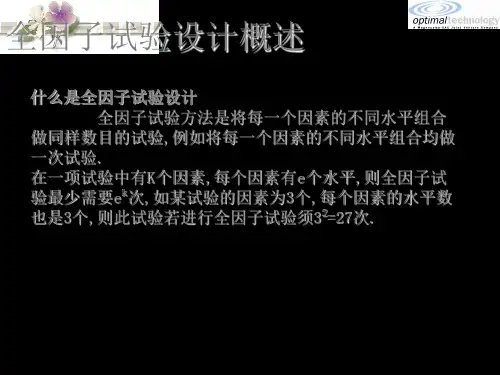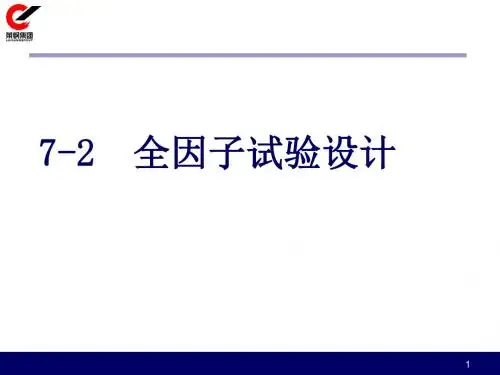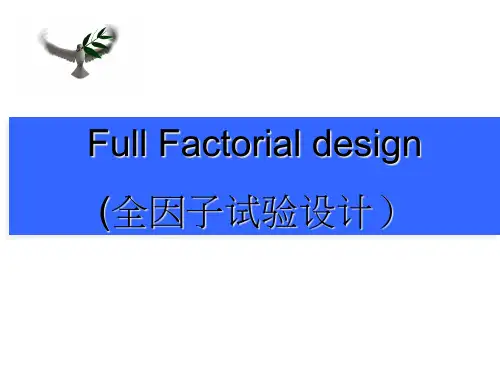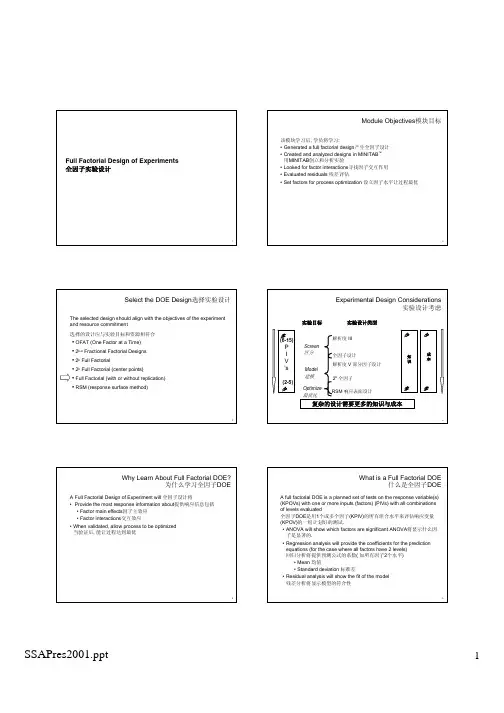《全因子试验设计》PPT课件
- 格式:ppt
- 大小:1.39 MB
- 文档页数:68










1Full Factorial Design of Experiments 全因子实验设计2Module Objectives 模块目标该模块学习后, 学员将学习:•Generated a full factorial design 产生全因子设计•Created and analyzed designs in MINITAB ™用MINITAB 创立和分析实验•Looked for factor interactions 寻找因子交互作用•Evaluated residuals 残差评估•Set factors for process optimization 设立因子水平让过程最优3Select the DOE Design 选择实验设计The selected design should align with the objectives of the experiment and resource commitment选择的设计应与实验目标和资源相符合•OFAT (One Factor at a Time) •2k-n Fractional Factorial Designs •2k Full Factorial•2k Full Factorial (center points)•Full Factorial (with or without replication)•RSM (response surface method)4复杂的设计需要更多的知识与成本Experimental Design Considerations实验设计考虑实验设计类型实验目标RSM 响应表面设计Optimize最优化Model建模解析度III全因子设计解析度V 部分因子设计2k 全因子Screen区分少多P I V ’s少多知识少多成本(6-15)(2-5)5Why Learn About Full Factorial DOE?为什么学习全因子DOEA Full Factorial Design of Experiment will 全因子设计将•Provide the most response information about 提供响应信息包括•Factor main effects 因子主效应•Factor interactions 交互效应•When validated, allow process to be optimized 当验证后, 能让过程达到最优6What is a Full Factorial DOE什么是全因子DOEA full factorial DOE is a planned set of tests on the response variable(s) (KPOVs) with one or more inputs (factors) (PIVs) with all combinations of levels evaluated全因子DOE 是用1个或多个因子(KPIV)的所有组合水平来评估响应变量(KPOV)的一组计划好的测试.•ANOVA will show which factors are significant ANOVA 将显示什么因子是显著的.•Regression analysis will provide the coefficients for the prediction equations (for the case where all factors have 2 levels)回归分析将提供预测公式的系数( 如所有因子2个水平)•Mean 均值•Standard deviation 标准差•Residual analysis will show the fit of the model 残差分析将显示模型的符合性7DOE TerminologyDOE 术语•Response 响应(Y, KPOV): the process output linked to the customer CTQ 与客户CTQ 相关的过程输出•Factor 因子(X, PIV): uncontrolled or controlled variable whose influence is being studied 被研究的非受控或受控变量•Factor Level 因子水平: setting of a factor (+, -, 1, -1, hi, low, alpha, numeric)一个因子的设置•Treatment Combination 处理组合(run 运行): setting of all factors to obtain a response 所有因子的设置以得到一个响应值•Replicate 复制: number of times a treatment combination is run (usually randomized)一个处理组合随机运行的次数•Inference Space 推断空间: operating range of factors under study 被研究因子的操作范围•MINITAB Design Matrix MINITAB 设计矩阵:a table with all the runs listed with the Factor Levels for each factor identified. In MINITAB it will also include Run Order and Standard Order Columns. The response is recorded against these runs 所有列出的运行在每一个因子的所有因子水平下的表格. 在MINITAB 软件中它包括运行顺序和标准顺序栏目. 响应值记录在这些运行后.•Fit 符合值: predicted value of the response variable, given a specificcombination of factor settings 响应变量的预测值, 已知一个特定的因子组合下•Residual 残差: the difference between a fitted (predicted) value and an actual experimental value 预测值与实际实验数据之差8Full Factorial DOE Objectives全因子DOE 目标•Learning the most from as few runs as possible.. 用尽可能少的运行来了解更多•Identifying which factors affect mean, variation, both, or have no effect 识别哪些因子影响均值, 方差, 都影响或都无影响•Optimizing the factor levels for desired response 最优化因子水平以得到需要的响应值•Validating the results through confirmation 通过确认来验证结果9Factorial Combinations 因子组合10Is testing all combinations possible,reasonable and practical?测试所有的组合可能吗?合理吗?可行吗?Combinations of Factors and Levels (1)因子和水平组合(1)•We have a process whose output Y is suspected of being influenced by three inputs A, B and C. The SOP ranges on the inputs are 过程输出Y 可能被3个输入因子A B C 影响. 输入的范围是: •A 15 through 25, in increments of 1从15 –25, 增量为1•B 200 through 300, in increments of 2从200 –300, 增量为2•C 1 or 21 或2•A DOE is planned to test all combinations 我们将设计一个实验来测试所有的因子组合11为做好实验我们必须对影响变量做假设Combinations of Factors and Levels (2)•Setting up a matrix for the factors at all possible process setting levels will produce a really large number of tests.设立一个包括所有可能设置水平的因子矩阵将产生一个相当大数量的实验.•The possible levels for each factor are 每个因子可能的水平包括•A =11•B =51•C =2•How many combinations are there?共有多少组合?•2 x 51 x 11 = ?A B C 152001162001172001182001192001202001212001222001232001242001252001152021162021172021 (22300223300224300225)300212The design becomes much more manageable!实验更好管理了!Factors at Selected Levels选择因子水平•The team decides, from process knowledge, that the test conditions of interest within the operating range of the factors (inference space) is as shown below.团队决定, 从过程知识中得知, 在因子操作范围( 推断空间)选择的测试条件如下:•A 15, 20, and 25•B 200, 225, 250, 275, and 300•C 1 and 2Tool Bar Menu > Stat > DOE > Factorial > Create Factorial Design2. 去掉Randomize runs(为教学用)3. 点OK 2. 输入每个因子的水平值, 因子水平间用空白搁开(不用逗号)3. 点OKStep 74 X 3 X 2 设计的标准顺序The StdOrder Column 显示运行如果设计没有随机化的运行顺序The RunOrder column 显示设计随机运行时的运行顺序注意: 当我们创建实验时, 因为我们没有勾Randomize 栏, StdOrder和RunOrder 是相同的.点OK不点randomize第1组复制Replicate第2组复制Response Y would be placed in C6响应变量值放在C6栏Step 4随机复制Response Y would be placed in C643Issues When Testing for Normality (1)正态测试(1)Test the Right Data 测试正确的数据Remember, the assumption in ANOVA is that the residuals are normal –therefore we test them, not the data记住, ANOVA 假设是残差是正态分布的-因此我们测试残差而不是数据Sample Size 样本大小•直方图需要大样本(推荐50个以上)•概率图不需要这样大的样本量•正态测试至少要25个样本, 但最好50以上•作为中心极限定理的结论, 当样本量大于20时, 大多数假设测试对非正态都稳健正态性测试总是比其他假设正态性的统计测试需要更多数据.44Issues When Testing for Normality (2)正态测试(2)Nature of Non-Normality 非正态本质•严重偏态数据比非正态对称数据更值得关注•严重偏态数据更容易用”转换”成正态数据•Log, Box-Cox Power Transformation, Square Root, Arcsine, etc.非参数替换-不适用于全因子,除非只有两个因子的特例•大多数非参数测试需要对称数据, 对严重偏态数据与参数测试一样敏感•所有非参数测试比相对应的参数测试效力差很多, 除非样本量很大(这种情况下参数测试非常稳健)如果数据严重偏态, 最好将其转换为正态而不是用非参数测试来替换45Steps for Testing Normality Assumption正态假设测试的步骤•Step 1: Test the right data (residuals) 测试正确的数据(残差)•Step 2: Graphical methods 图象化方法•Histogram of residuals 残差直方图•Normal probability plot of residuals 残差正态概率图•Step 3: Statistical tests 统计测试•Anderson-Darling test (preferred) 推荐•Chi-Square goodness of fit test 卡方符合性测试如果可能尽量用图象化工具46Graphical Methods for Checking Normality (1)正态测试的图象化方法(1)109876543212010Right Skewed F r e q u e n c yP-Value: 0.004A-Squared: 1.177Anderson-Darling Normality TestN: 100StDev: 2.30456Average: 4.38216108642.999.99.95.80.50.20.05.01.001P r o b a b i l i t yRight SkewedNormal Probability PlotUse a histogram and probability plot together 同时使用直方图和概率图•Histogram for visualizing shape 直方图显示形状•Probability plot for precision 概率图显示精确性右偏分布数据低段出现低迷–左尾太多数据47Graphical Methods for Checking Normality (2)2019181716151413121110105Fat Tails F r e q u e n c yP-Value: 0.043A-Squared: 0.772Anderson-Darling Normality TestN: 100StDev: 2.81680Average: 14.9555201510.999.99.95.80.50.20.05.01.001P r o b a b i l i t yFat TailsNormal Probability Plot 两端出现低迷肥尾分布Use a histogram and probability plot together 同时使用直方图和概率图•Histogram for visualizing shape 直方图显示形状•Probability plot for precision 概率图显示精确性48Statistical Tests for Checking Normality正态性检验P-Value: 0.043A-Squared: 0.772Anderson-Darling Normality TestN: 100StDev: 2.81680Average: 14.9555201510.999.99.95.80.50.20.05.01.001P r o b a b i l i t yFat TailsNormal Probability PlotGraph > Probability Plot…49Equal Variances 等变差•统计建模技术(ANOVA 和回归等)假设残差有相等的变差•不等的变差影响P 值和效力计算-导致效力降低和P 值比实际小•大多数统计测试技术对不等变差十分稳健,特别是当样本数量相等和近似相等时(对ANOVA, 意味着每个因子的每个水平的运行次数, 或2个或多个因子的每个水平下的运行次数是相同的)•转换将能纠正该问题50Issues When Testing for Equal Variances等变差测试Sample Sizes 样本量•当组的大小相等或接近相等时, 成组数据测试(ANOVA)对不等变差是十分稳健的Non-Parametric Alternatives 非参数测试替换•不适用全因子,除非2因子特例•除非样本量十分大, 所有参数测试都没有相对应的参数测试有效力. •大多数非参数测试需要分布有相同的形状, 即对不等变差同样敏感If the variance increases as the mean increases, it is better to try a transformation than a non-parametric alternative!!如果变差随均值增加而增加, 最好用转换而不用非参数替换51Steps for Testing Equal Variance Assumption等变差假设测试步骤•Step 1: Test the right data (residuals) 测试正确的数据或残差•Step 2: Define the right test 定义正确的测试•Equal variances for all residuals (one group of data)所有残差组的变差相等•Step 3: Graphical methods 图象方法•Residuals vs. fits•Step 4: Statistical tests 统计测试•F test for 2 variances F 测试2变差•Bartlett’s and Levene’s tests for > 2 variancesBartlett’s and Levene’s 测试超过2变差如果可能尽量用图形方法52Testing Assumptions for Residuals残差假设测试-101012345678ResidualF r e q u e n c yHistogram of Residuals10203040-20-1001020Observation NumberR e s i d u a lI Chart of ResidualsM ean=-3.2E -15UC L=17.63LCL=-17.63708090-15-10-50510FitR e s i d u a lResiduals vs. Fits-2-112-15-10-50510Normal Plot of ResidualsNormal Score R e s i d u a l正态性检验独立性检验等变差检验本例中均符合假设图形检验三个假设53The Importance of Orthogonal Designs正交设计的重要性当因子间相关性为0时, 因子在数学上独立•Only the response is a function of the factors 只有响应变量是因子的公式•A factor is not a function of another factor 一个因子不是另一个因子的公式当因子独立且实验设计完全平衡时, 因子正交•Each level of a factor appears the same number of times 因子每水平出现相同次数正交设计很重要, 因为: •设计中每项都能从其他项中独立地测试•从模型中去处一项不影响其他剩余项•正交设计保证因子是独立的•正交设计让不等变差分析更稳健54Types of Orthogonal Designs正交设计类型•Full factorial experiments 全因子•2-level full factorial experiments 2水平全因子•2-level fractional factorial experiments 2水平部分因子•Plackett-Burman and Taguchi arrays Plackett-Burman 和田口设计•Some response surface experiments 一些响应表面设计使用正交设计以确保因子们是独立地因为设计是平衡地, 正交设计也让不等变差的分析更稳健Tool Bar Menu > Stat > DOE > Factorial >Create Factorial点Design 按钮Click OK Click OK, then OK againStat > DOE > Factorial > Analyze Factorial Design点OK,再点OK Stat > DOE > Factorial > Factorial Plots67Draw Conclusions (11)28321516120130140Wheel SizeAir PressureM e a nInteraction Plot - Data Means for Stop Dist当Air Pressure = 32 和Wheel Size = 15 的响应均值.交互作用不显著. 注意: 两条线平行的.Air Pressure 保持在28 psi 时的Wheel Size 的主效应图.Air Pressure 保持在32 psi 时的Wheel Size 的主效应图.交互作用图-停止距离的数据均值68Steps to Conduct a Full Factorial Experiment 实施全因子实验设计的步骤步骤•Step 1: 描述实际问题和实验目标•Step 2: 描述因子和水平值•Step 3: 决定适当的样本大小, 给定α and β 风险•Step 4: 用MINITAB 创建一个实验设计. 实验设计表上的运行应随机.•Step 5: 实施实验•Step 6: 全模型实验分析•Step 7: 简化模型•评估ANOVA 表, 消除P 值大于0.05的项.•先消除最高阶项, 再到更低项, 最后是主效应项.•一次消除一项Terms should be removed one at a time.•不应消除包含在高阶项中的任何项, 以保证层级的完整.•最终模型中只包括那些P 显著的项•Step 8: 检查是否违反假设•分析简化模型的残差以确保我们具有适当的模型•Step 9: Determine optimal settings by graphically analyzing remaining terms 用图形分析决定保留项的最优设置•Interactions (using interaction plot) 交互图•Look at the highest order interactions first.先看最高级别交互.•一旦最高级别交互作用能解释后, 继续分析更低级别的交互•Main Effects (using main effects plot)主效应图•主效应图用来决定未经交互作用图决定的因子设置•Step 10: 计算每项的能解释的变差比例(epsilon square)•Step 11: 重复实验优化条件以验证结果•Step 12: 最终报告Steps to Conduct a Full Factorial Experiment71Full Factorial Example (1)全因子例子你负责一个项目, 检查一个呼叫中心的来电. 其中一个事项是电话保留时间总和. 显然你希望该时间能越短越好, 并且能尽可能一致..你将设计一个实验来确定是否不同的承包商和不同的电话系统,对保留时间有任何影响.有3个承包商: HiTech OnTimeAcme3个电话系统:PBXContractPhoneCo72Full Factorial Example (2)Step 1: 陈述实际问题和实验目标:确定什么影响保留时间, 发现最好的组合来减少保留时间Step 2: 陈述因子和水平设置:因子水平Vendor:HiTech OnTime Acme Phone System:PBXContractPhoneCoStep 3:确定适当样本量, 给定α and β risks 已经决定要有4个复制.为教学起见,我们未随机化runsStep 5: 实验实施要点:运行实验和收集数据前, 必须确保因子和响应变量的测量系统是可靠的. (MSA)打开文件: W3 CallCenter.mtw利用我们学习的技术进行分析:模型选择/简化/模型因子设置分析/假设检验产生残差图方法Note: This method generateseach graph separately.Enter the fits and residuals you stored…Title is totally optionalPhone System 占47%2)选择一般全模型4)点OK to 选择defaults, 点OK againTo get the 2-way interaction for CNC fill in as shown, repeat for mill. After both plots are made,模块回顾Module ObjectivesBy the end of this module, the participant will:学习到:•Generate a full factorial design•Create and analyze designs in MINITAB™•Look for factor interactions•Evaluate residuals•Set factors for process optimization103。
